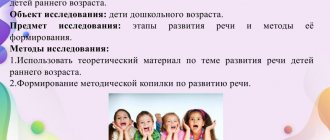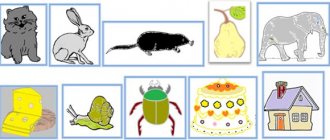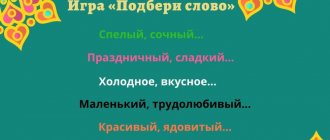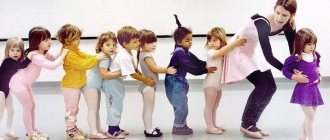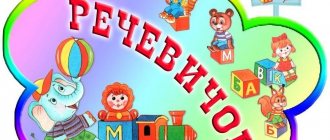After two years of life, speech plays the main role in the development of the psyche and the formation of behavior. There are various forms of child speech development. If up to two years of age a child used 300 words in his speech, then, subject to skillful pedagogical influence, up to three years of age the vocabulary expands to 1000 or more words.
Expanding his life experience under the guidance of an adult, a child of 2-3 years old learns to establish elementary cause-and-effect relationships between objects of the external world, understands and poses many different questions himself.
One of the effective forms of developing a child’s speech is daily individual communication with him. With his questions and answers to the child’s remarks, the teacher provides him with information that requires additional clarification. In the process of such communication, you can suggest a new word to the child and help build a simple language structure.
Complex classes
A complex lesson in its structure combines at least three speech tasks. Tasks for the development of communicative activity (dialogical and coherent speech) are implemented at each of them; tasks of vocabulary work, sound culture of speech and grammatical structure of the language as part of a complex lesson are planned twice a month. The teacher himself determines which part of the lesson to start from, depending on the complexity of the tasks and the age of the children.
Approximate structure of a complex lesson: I week - communicative activity + sound culture of speech + grammar; Week II - communicative activity + grammar + vocabulary; Week III - communicative activity + vocabulary + sound culture of speech.
System of work on speech development of preschool children
Natalya Olkhovaya
System of work on speech development of preschool children
The objectives of the preschool educational institution’s work on the speech development of preschool children are :
— mastery of speech as a means of communication and culture;
- enrichment of the active vocabulary, development of coherent , grammatically correct dialogical and monologue speech;
— development of speech creativity;
-development of sound and intonation culture of speech, phonemic hearing;
— acquaintance with book culture, children’s literature, listening comprehension of texts of various genres of children’s literature;
— formation of sound analytical-synthetic activity as a prerequisite for learning to read and write.
In the process of organizing work on children’s speech development, we use the following approaches:
1. An integrated approach to the development of oral speech , providing:
– understanding speech, attracting children’s to their own speech and the speech of others;
– development of coherent dialogic and monologue speech;
– enrichment and clarification of the dictionary;
– development of the grammatical structure of speech;
– development of the speech apparatus , sound pronunciation;
– development of fine motor skills
2. Practical mastery of speech norms and their application in various forms and types of children's activities.
3. Development of children's oral speech in conjunction with other mental processes.
Work in this area is built on the principles of systematicity , consistency and continuity.
Creating conditions for the full development of children’s speech , we provide:
— creation of a developing subject-spatial environment;
- purposeful work of educators on the speech development of children in all types of children's activities and in close cooperation with parents;
— increasing the professional growth of teachers in matters of speech development of preschool children ;
— study of the state of speech development of children during preschool childhood ;
An important place in the work on the speech development of preschool children is occupied by the effective organization developing subject-spatial environment in accordance with the Federal State Educational Standard for Educational Education. Speech corners in all age groups of preschool educational institutions . Certain requirements for their content have been developed Teachers have accumulated and systematized a variety of practical material for organizing speech games and classes : manuals for articulation exercises, sets of finger games, thematic albums, games for enriching vocabulary, developing grammatical structure, coherence
speech, development of phonemic hearing and fine motor skills, role-playing games. The developmental environment of each age group is complemented by different types of theaters, which are of no small importance in the speech development of children .
organize educational work on speech development in preschool educational institutions, taking into account the age and individual characteristics of children .
The leading form of work on the development of children's speech is an educational situation, which involves the participation of a group or subgroup of children , depending on their desires and the characteristics of the content of the situation. We organize many educational situations aimed at solving gradually more complex problems: teaching methods of friendly business communication with an interlocutor, teaching how to ask questions, arranging them in a logical sequence, learning how to summarize received information into a story, teaching methods of presenting a compiled text. Let me give you an example of such a situation : “Good greetings”
, during which we got to know children with various forms of greeting:
“I’m so glad to see you
,
“How I missed you
,
“It’s so good that we met
.” As communication situations, we conduct quiz games:
“Come up with a riddle "
(exercise
for children in describing objects, inventing riddles, "Who knows the nature of their region better?"
(exercise in perceiving and composing descriptive stories with a regional component,
"From which fairy tale are things"
(exercise in
the development of explanatory speech , "Shop of magical things" (an exercise in using the means of linguistic expression)
.
also use project activities in our work as one of the technologies. The project activity traces the integration of all educational areas, but the basis of this method is the child’s speech development .
When using this technology, there is close interaction between the teacher, the child and his parents, as well as step-by-step practical activities that lead to achieving the set goal.
Each group in our kindergarten implements various projects. I work in a compensatory group for children with general speech underdevelopment and I would like to note that we, teachers, our children and parents really like project activities. We implemented the project “For children about the Second World War and Victory Day”
, the purpose of which was to activate the existing knowledge and expand the horizons
of children with new knowledge about war and Victory, speech task : development of monologue speech , speech creativity , listening comprehension of texts of a patriotic nature, a product of a leisure project dedicated to Victory Day. We worked on the projects “Firefighter is an important and necessary profession”
,
“Me and my mother”
,
“Wintering birds”
,
“Vegetable garden on the windowsill”
,
“My small homeland”
.
And, of course, the main form of speech development in children is play .
During the day we use various forms of work : educational activities, conversations about the seasons, about professions, about birds, about animals, about moral topics, word games “Describe the object”
, "Edible -
inedible", "Add a word"
,
“Pick a sign”
, didactic games
“Magic Mat”
,
“Help fairy-tale characters get into their fairy tale”
,
“Correct the mistake”
, individual
work , elements of theatrical activities, creating speech situations (for example: lost in the park; lost in a store; meeting with an unfamiliar adult; with an unfamiliar boy or girl).
We widely use artistic expression when organizing routine moments. We offer children subject and subject pictures, illustrations, books for independent examination in order to develop initiative speech , enrich and clarify ideas about objects in their immediate environment, enrich passive vocabulary, and activate coherent speech. During educational activities, we pay great attention to the development of vocabulary . We carry out systematic work on the formation of coherent, grammatically correct dialogical and monologue speech. Work is constantly underway on the sound culture of speech, both during educational activities and in special moments. In music classes, work on intonation expressiveness, clear diction, and breathing. During educational activities, to create interest in classes, we use children’s and create problematic situations. We pay attention to the quality of children’s and correct grammatical inaccuracies. All this creates a favorable environment for the development of children's speech .
The inclusion of parents in the pedagogical process is also the most important condition for the full speech development of children . For parents, we hold parent meetings in a non-traditional form (in the form of master classes, round tables, KVN)
;
consultations “ Speech environment in the family and its influence on the development of the child’s speech ”, “The role of parents in
the development of children’s speech ” , “Familiarization with the characteristics of
the speech development of children of a certain age ”, “Playing with fingers -
developing speech ” ,
work on projects , visiting educational activities on speech development (Open Days)
.
And in conclusion, I would like to note that the system of work on the speech development of preschoolers will be effective if:
- children jointly solve an educational and gaming task that is interesting and meaningful to them, acting as assistants in relation to someone,
— enrich, clarify and activate their vocabulary by performing speech and practical tasks,
— the teacher is not a tough leader, but an organizer of joint educational activities, who does not advertise his communicative superiority, but accompanies and helps the child become an active communicator.
Integrated classes
Integrated forms of classes for consolidating acquired knowledge, skills and speech habits with children of the third year of life can be carried out 1-2 times a quarter. In these classes, the teacher uses material from different sections of the program, combining several areas of children's activities (for example, speech and visual arts, speech and cognitive). The priority in such classes is the communicative activity of children, the unifying point is the theme.
In early age groups of 2-3 years old, it is advisable to conduct educational and game integrated classes, which provide for the presence of a game plot and a single storyline.
Mini-lessons
Mini-classes of speech development are recommended by current programs to be used as special forms of speech development in work with children of the third year of life as often as possible (preferably daily), because they are relevant and correspond to the personality-oriented model of preschool education. This form of organizing speech activity can be initiated by the teacher, then they are provided for in the work calendar, or it can arise on the initiative of the children. The teacher must be prepared to guide such speech activity of the child.
The part of the word “mini”, according to A. Goncharenko, implies minimization:
- by the number of children who are simultaneously employed;
- by duration of organized activity;
- by the volume of content that is sold.
The number of mini-lessons and their content are determined by age characteristics. During the day, the teacher can organize himself or create conditions for children to self-organize dozens of individual, group and collective short-term mini-lessons, during which the planned topic will be implemented.
Forms and means of speech development for preschool children article on speech development
Forms and means of speech development in preschool children.
In modern preschool pedagogy and in the methodology of speech development in particular, V. I. Yadeshko, O. I. Solovyova, A. M. Borodich, M. M. Alekseeva, V. I. Yashina distinguish two main forms of speech teaching: the first is special speech development classes; the second is work on developing children’s speech in free communication with the teacher, with all other kindergarten workers, and in children’s communication with each other. Free verbal communication of a child in kindergarten occurs:
a) in everyday life (morning, evening toilet, eating, etc.);
b) during walks;
c) during games;
d) when getting acquainted with the environment (social life and nature in all seasons);
e) in the process of labor (household, manual, labor in nature);
f) during holidays and entertainment;
g) during non-verbal classes: on the formation of elementary mathematical concepts, drawing, modeling, design, physical education, music.
Special classes on speech development are conducted with the aim of providing methodological assistance in the child’s acquisition of speech both as a means of communication and cognition, and as a means of regulating one’s own behavior. When organizing classes on speech development, according to L.P. Fedorenko, G.A. Fomicheva, it is necessary to take into account that all aspects of a child’s speech must be developed in parallel, simultaneously, and not one by one, since they are all interconnected. Therefore, in one lesson you have to solve several language problems, one of which will be the main one, and the others - accompanying ones. For example, if the formation of an idea of a sentence is the main task, then morphological analysis of cognate words and exercise in clearly pronouncing the difficult sound found in these words will be accompanying in the lesson.
Solving several language problems requires a more complex lesson structure (two or three parts). However, it is desirable that all the material mastered in one lesson be combined thematically in content. This will allow children to concentrate their attention on solving language problems and spend their nervous energy sparingly, without wasting it on engaging in various types of work.
When determining the number of parts in a lesson, formalism should not be allowed. The number of language tasks and the number of parts in one lesson depends on the level of the children’s skill, on the complexity of the task, on the volume and stylistic complexity of the work of art used in the lesson, etc.
When planning classes, it is important to provide for consolidation of the knowledge, skills and abilities acquired by children, which means repeated exercises on homogeneous material, easier or more complicated depending on success. These exercises should be adjacent in time to prevent the skill from fading away in the process of its formation. For example, to develop intonation expressiveness in dialogue (question, answer), the teacher reads the folk song “Where did you go, mouse?” in class. Children learn it completely by heart. At the next lesson, several pairs of children role-play this song and try to dramatize it. The final development of the dramatization of this song is carried out outside of class, in the morning or evening hours; The dramatization game is performed by children at one of the leisure evenings, at a holiday in kindergarten.
When planning classes on speech development, the teacher must build them based on the basic principles of the methodology, remember that the methods and techniques of work are determined both by the laws of the language being mastered and by the age-related psychological laws of perception, memory, imagination, and thinking of children of this group.
Thus, the imitation method is used in older age groups - at the initial stage of development in children of new, more complex speech skills. For example, when introducing children to a sentence, the teacher says several sentences out loud, says that a sentence can be said about every object that is near or far from us, and invites the children to come up with sentences. Imitating examples, they come up with sentences about toys, pieces of furniture, plants and paintings that decorate the group room, or about objects and phenomena outside the kindergarten.
When teaching how to invent stories, the teacher first demonstrates his sample story. Then, reminding the children of its structure and plan (“Where was it? When? How did it all start? What happened next? How did the story end?”), he invites them to come up with their own stories. Children, when composing a story based on a model, sometimes have difficulty overcoming the urge to directly copy the content. The teacher must take this into account and lead their thoughts to “his” content.
The conversation-conversation method is appropriate for activating children’s speech reserves and encourages them to appropriately use words and different sentence structures. At the same time, in older groups, the method of relying on verbal didactic games is used.
The retelling method is widely used in working with older children. With its help, children's speech is enriched with all components of the language (vocabulary, grammar, intonation). They practically master coherent dialogic and monologue speech using the best examples of fiction. The teacher’s task when planning lessons on retelling works of fiction is to select texts that are accessible in content and style of presentation to children of a given age group.
The composition method involves the use of different techniques for teaching children creative storytelling: from perception (observation), from memory, from imagination.
Also, when planning each lesson, methods of working with children are determined. They can vary in degree of complexity (degree of abstraction): perception and description of natural objects and their models (toys); the use of visual aids perceived visually (paintings, illustrations, filmstrips and films); verbal techniques - samples of teacher speech, literary texts, questions-tasks, instructions, explanations, tape recordings, verbal didactic games, dramatization games. The choice of working methods is determined both by the content of the language task to be solved with children (phonetics, vocabulary, grammar), and by the level of development of speech skills at the time of this lesson.
A special place is occupied by textual didactic material - fairy tales, songs, poems, stories, riddles, proverbs, sayings. This material on the topic must correspond to the content of the lesson, its educational purpose, correspond to the didactic task, provide the opportunity to exercise children in sound analysis or pronunciation of sounds, or in the morphological analysis of a word in order to determine means of expression, etc. This material must be artistic , imaginative and understandable for children of this age group (volume, complexity of content, number of new words-concepts, their complexity, etc.)
Every day at the end of the work shift, the teacher sums up the results of working with children. Competently and timely taking into account the work means determining the following: whether the language task(s) were feasible for the children to master, who and why did not cope with the task; whether the measure of the teacher’s speech activity has been met; whether the choice of literary text, which has become the subject of practical development, is successful; how effective were the methods of working on this language material, etc.
Organization and recording of work are interconnected: well-planned and executed work makes it possible to trace the process of children’s speech development, and timely and competently carried out recording makes it possible to make this process more effective - to plan language work, focusing not only on age, but also on the speech characteristics of the children in question, specific team.
Work outside of class is of great importance for the full speech development of older children. They are given exercises and games to consolidate the skills acquired in classes in all sections of speech development methods.
O. S. Ushakova suggests carrying out additional work with children who have deficiencies in sound pronunciation, in small groups (if they have the same deficiencies) or individually. The teacher uses speech gymnastics, tongue twisters, and tongue twisters. Outside of class, work is also carried out to improve the intonation expressiveness of speech and the development of speech breathing. For example, a teacher suggests to one child that he first recites a poem a little louder than usual (as if he is speaking in front of the whole group), then in a low voice (for one person), then at normal volume (for several), and finally in a whisper (as if in secret).
Moments of everyday life are also widely used for the full development of vocabulary and for consolidating speech skills. During play and routine processes, children’s verbal communication is organized and conditions are created for each child’s speech activity. According to A. M. Borodich, their work activity, especially collective work, is extremely important for the development of children’s vocabulary. Children understand the meaning of many words because they are associated with sensory perceptions, and the nature of work communication contributes to the child’s use of acquired words and consolidation of them in memory.
Children's vocabulary is also enriched in the process of becoming familiar with art. Watching television programs and movies greatly expands children's horizons and makes new words clear to them thanks to a combination of visual and auditory perceptions. The activation of vocabulary, especially figurative ones, is facilitated by dramatization games, puppet and table theater shows.
When organizing work outside of class, the teacher must constantly monitor the grammatical correctness of children’s speech. An uncorrected grammatical error is an unnecessary reinforcement of incorrect conditional connections not only for the speaking child, but also for other children hearing him at the moment.
You need to correct a mistake kindly, tactfully and not in moments of the child’s emotional state or creative upsurge. You should not repeat the mistake; it is better to say the correct form repeatedly. Correcting an error will be more effective if the teacher gives the child similar examples.
With children who make mistakes in inflection, word formation, and sentence construction, the teacher organizes games that reinforce preschoolers’ understanding of sentences and words. For example, “Living words”, “Say the end of the word”, etc.
Everyday life provides great opportunities for developing coherent speech skills. For this purpose, it is necessary to specially organize various conversations and conversations with children (“About the past day off”). At the same time, it is necessary to pose questions correctly so that children learn to talk in detail about certain events. The child begins to talk, and the teacher and a small group of children listen to him. If the story turns out to be interesting, the teacher writes it down and then reads it to all the children. You can prepare an album of children's stories: the children will draw the stories, and the teacher will write the text. It is recommended to use a technique such as an assignment: show a friend who was sick the crafts and tell them in order how they were completed. Organize role-playing games, for example, “Radio” (the role of an announcer).
In working with children to familiarize themselves with fiction outside of class, A. M. Borodich identifies two directions: the first, when the teacher purposefully organizes preschoolers to perceive works, and the second, the independent use of works by children on their own initiative with the indirect participation of an adult.
The content of a teacher’s active activities outside of class includes reading and telling children works of fiction.
Outside of class, it is good to read works about nature, lyrical poems, nursery rhymes, jokes, etc. Such reading can be provided for and scheduled in the calendar, for example, read the poems of E. Serova while walking. Every day, the teacher’s speech should include excerpts from works of art, for example from the poem “All Year Round” by S. Marshak, as well as proverbs, riddles, etc.
The weekly schedule also provides for the day and hour of repetition of poems memorized in class.
A child’s independent artistic and speech activity reflects a variety of impressions from books read, films and performances watched, as well as artistic skills acquired in classes. One of the conditions for the development of such independent activities is that the group be equipped with the necessary equipment and aids, and have places to store and use them.
A special role belongs to entertainment and holidays, where works of art are presented both in unadapted form and in the form of adaptations and dramatizations.
Since education in the broad sense (and the formation of speech included in this concept) is carried out by adults through some kind of activity, these types of activities can be conditionally called means. That is, any activity can be considered a means of developing the speech of children of senior preschool age if it is led and directed by an adult.
Any interaction between an adult and a child is not possible without communication with him, therefore, the most important means of speech development is communication. Communication is the interaction of two (or more) people aimed at coordinating and combining their efforts in order to establish relationships and achieve a common result. Communication is a complex and multifaceted phenomenon of human life, which simultaneously acts as: a process of interaction between people; information process; a means and condition for the transfer and assimilation of social experience; the attitude of people towards each other; the process of mutual influence of people on each other; empathy, mutual understanding of people (B.F. Parygin, V.N. Panferov, B.F. Bodalev, A.A. Leontyev, etc.).
Speech does not arise from the very nature of the child, but is formed in the process of his existence in the social environment, according to M. M. Alekseeva, V. I. Yashina. Its emergence and development are caused by the needs of communication, the needs of the child’s life. Contradictions that arise in communication lead to the emergence and development of the child’s linguistic ability, to his mastery of ever new means of communication and forms of speech. This happens thanks to the cooperation of a child with an adult, which is built taking into account the age characteristics and capabilities of children. The presence of an adult stimulates the use of speech; children begin to speak only in a communication situation and only at the request of an adult. Therefore, in the method of speech development it is recommended to talk with children as much and as often as possible.
In preschool childhood, several forms of communication between children and adults consistently appear and change: situational-personal (direct-emotional), situational-business (subject-based), extra-situational-cognitive and extra-situational-personal. The nature of communication determines the content and level of speech development of children. Therefore, the organization of meaningful, productive communication between teachers and children is of paramount importance.
Speech communication in preschool age is carried out in different types of activities: in play, work, everyday life, education, and therefore each of them can also be considered as a means of speech development.
Thus, play is not only a fertile condition for children’s speech manifestations, but also an effective means of influencing the quality of children’s speech. Each type of game has a special meaning. In creative role-playing, the functions and forms of speech are differentiated. Dialogue speech is improved in it, and the need for coherent monologue speech arises. But not every game contributes to the development of children's speech. First of all, it must be a meaningful game. The teacher’s participation in children’s games, discussion of the concept and course of the game, and drawing their attention to the word have a positive effect on children’s speech.
Outdoor games with text, dramatization games contribute to the development of speech activity, taste and interest in the artistic word, expressiveness of speech, artistic speech activity, influence the enrichment of vocabulary, develop the correct tempo and breathing, and diction.
Construction games replenish and activate children's vocabulary through the most difficult words for preschoolers: designations of quality, size, spatial arrangement of objects (large, heavy, long, below, inside, behind, etc.), terms (arch, ceiling, plywood, etc.). d.).
Didactic and printed board games are used to solve all speech development problems.
Children's work—household, manual, agricultural—is an effective means of enriching their vocabulary, a means of developing verbal communication skills. Conversations and stories about the labor process serve to activate the acquired vocabulary and develop coherent speech.
Children's everyday activities, when properly guided by a teacher, are also a means of speech development. The advantages of this means are the naturalness of the environment, in which many children enter into conversation more easily, the combination of the content of speech with real relationships that develop in life, the teacher has enough time, which allows him to talk with many children, and diversify the topics of these conversations. During everyday activities, children's vocabulary is extremely enriched, speaking skills are formed, the teacher makes extensive use of works of art and folklore.
One of the main means of speech development is training. This is a purposeful, systematic and planned process in which, under the guidance of a teacher, children master a certain range of speech skills and abilities.
The most important form of organizing speech and language teaching in speech development methods is considered to be special classes in which the main tasks of children’s speech development are set and purposefully solved.
In the older group, the nature of classes changes. More verbal classes are conducted: various types of storytelling, analysis of the sound structure of a word, the composition of sentences, special grammatical and lexical exercises, and word games. The use of visualization is taking on other forms: paintings are being used more and more - wall and tabletop, small, handouts. The role of the teacher is also changing. He still leads the lesson, but he promotes greater independence in children’s speech and uses speech patterns less often. Children's speech activity becomes more complex: collective stories are used, retellings with text restructuring, reading in faces, etc. But we should not forget that these are preschool children, so dryness and didacticism must be avoided.
The next means of speech development in a broad sense, according to M. M. Alekseeva and V. I. Yashina, is the cultural language environment. Imitating the speech of adults is one of the mechanisms for mastering the native language. It should be borne in mind that by imitating those around them, children adopt not only all the subtleties of pronunciation, word usage, and phrase construction, but also those imperfections and errors that occur in their speech. Therefore, high demands are placed on the teacher’s speech: content and at the same time accuracy, logic; appropriate for the age of the children; lexical, phonetic, grammatical, orthoepic correctness; imagery; expressiveness, emotional richness, richness of intonation, leisurelyness, sufficient volume; knowledge and compliance with the rules of speech etiquette; correspondence between the teacher’s words and his deeds.
In the process of verbal communication with children, the teacher also uses non-verbal means (gestures, facial expressions, pantomimic movements). They perform important functions: they help to emotionally explain and remember the meaning of words.
Fiction is the most important source and means of developing all aspects of children's speech and a unique means of education. It helps to feel the beauty of the native language and develops figurative speech. It is used to form the sound culture of speech, assimilate morphological patterns and syntactic structures. E.A. Flerina notes that a literary work gives the child ready-made linguistic forms, verbal characteristics of images, definitions with which he subsequently operates. The contextual meaning of words and expressions included in literary works contributes to the enrichment of vocabulary, as well as figurative speech (O. S. Ushakova, L. A. Kolunova, etc.)
Drawing, music, and singing are also used in the interests of children's speech development. The emotional impact of works of art stimulates language acquisition and creates a desire to share impressions. Emphasizes the purpose of verbal interpretation of works, verbal explanations for children for the development of imagery and expressiveness of children's speech.
Thus, in work on the development of speech of older preschoolers, two main forms are distinguished - these are specially organized classes on speech development and work on speech development in the free communication of children with adults and among themselves (in everyday life, during walks, during games, during familiarization with others, in the process of work, during non-speech activities).
Language tasks mini-lessons
In any mini-lesson, language tasks are implemented. In mini-lessons, children 2 and 3 years old have the opportunity to independently learn, explore, comment on what has been done, share impressions with peers and adults, choose the time to complete the task proposed by the teacher, and exercise the right to independently choose activities and partners.
Mini-lessons can be considered as an innovative approach to organizing the life activities of a young child, because they contribute to both the formation of an understanding of the speech of the native language and the development of active speech. An innovative component in the proposed approaches is the way of organizing children (subgroups of 3-4 children), the form of organization (mini-lesson), the content and layout of the material (the use of music and exercises for the development of fine and gross motor skills, visual and object activities, which is accompanied by a speech commentary ).
Technologies for speech development of preschool children according to the Federal State Educational Standard
Modern technologies of speech development of children in the context of the implementation of the Federal State Educational Standard for preschool education
“Pedagogy should focus not on yesterday, but on tomorrow’s child development, only then will it be able to bring to life in the process of learning those processes that now lie in the zone of proximal development” L. S. Vygotsky
Dear colleagues, I bring to your attention the topic of the public lecture: “Modern technologies for the speech development of children in the context of the implementation of the Federal State Educational Standard for preschool education.”
In the Federal State Educational Standard of Preschool Education, “Speech Development” is highlighted as the main educational area. (on slide) Currently, the development of children’s speech remains one of the pressing problems of modern preschool education. And the defining moment in successfully solving the problems of speech development in preschool children is the correct choice of pedagogical technologies that would not only be adequate to the age-related capabilities of the children, but also provide the ability to easily solve speech problems in various forms of working with children. The organization of children's speech development in educational activities involves the search for effective technologies for the development of children's speech. Pedagogical technologies are a system of methods, methods, teaching techniques, educational tools aimed at achieving a positive result through dynamic changes in the personal development of a child in modern conditions. You can see the requirements for choosing technologies on the screen. In connection with the above, I bring to your attention a disclosure of the following technologies used in my practice 1. The first technology that I want to talk about is probably often used by practicing teachers - this is the method of visual modeling or (mnemonics). 1.1. Mnemonics (translated from Greek as “the art of memorization”) is a system of various techniques that facilitate memorization. What is strongly associated is remembered, but what does not form strong associative connections. - is forgotten. K. D. Ushinsky wrote: “Teach a child some five words unknown to him - he will suffer for a long time and in vain, but connect twenty such words with pictures, and he will learn on the fly.” The objectives of using mnemonic teaching aids are presented on the slide: Like any technique, work using mnemonics is built from simple to complex. First, the work uses the simplest mnemonic squares and mnemonic tracks, and then mnemonic tables are gradually introduced. To enrich their vocabulary and when guessing and making riddles, children with great pleasure use mnemonic squares and mnemonic tracks. When learning to compose stories, when retelling fiction, when memorizing poetry, mnemonic tables serve as effective didactic material. A mnemonic table is a graphic or partially graphic image of the characters of a fairy tale, natural phenomena, some actions, etc. The supporting image in the table is the image of the main characters of the fairy tale, as well as those objects, actions and phenomena that are “tied” around them. Mastering the action of visual modeling contributes to the development of children's mental abilities. The child learns to compare, generalize, group material for the purpose of memorization, speech, memory and thinking develop. One of the visual modeling techniques is a geometric diagram - Euler circles. With the help of symbols, children visually display relationships between concepts or sets of objects, laying them out in their circle. Then, at the intersection of circles (Euler circles), identical attributes of objects are identified. Children compare objects, first determining their similarities and then their differences. Euler circles are used in teaching creative and narrative storytelling. CONCLUSION: Thus, using this gaming technology in my work, I shape the social experience of children, exercise their ability to find objects that have not one, but several characteristics at once, and solve a whole class of interesting speech and logical problems that a child needs when preparing for school. 2. Next, I want to dwell on the technology of activating speech training as a means of communication (author Olga Alfonsasovna Belobrykina). According to the author of the technology, the most important prerequisite for improving the speech activity of preschool children is the creation of an emotionally favorable situation that promotes the desire to actively participate in verbal communication. The main activities of a preschooler include play and communication, therefore, play communication is the necessary basis within which the formation and improvement of the child’s speech activity occurs through the use of linguistic games. Linguistic games presented in this technology make it possible to develop various types of speech activity, each child can easily and freely demonstrate intellectual initiative, which is a specific continuation of not just mental work, but cognitive activity, not determined by either practical needs or external assessment. Dear colleagues, I offer you this exercise. Let's try to name the complete proverbs in two words. – Feeds, spoils CLICK – Labor feeds, but laziness spoils – House, walls CLICK – Houses and walls help – Family, soul CLICK – Family together – the soul is in place. Amazing! The most important condition for the development of speech is the creation of a comfortable communicative field in the family, as well as the sincerity and appropriateness of the inclusion of speech etiquette formulas in various communication situations. The introduction of speech etiquette formulas into the speech communication of preschoolers is also facilitated by special didactic family games and exercises, which are presented in the collection “System of work on the formation of speech etiquette and a culture of communication.” The common goal of both the family and the kindergarten is a well-mannered, cultured and educated person. In this collection, I have developed a system of rules for brave and persistent parents, formulas and situations of speech etiquette. I draw your attention to the slide: Today we need people who are intellectually courageous, independent, original thinkers, creative, and able to make non-standard decisions. Pedagogical technologies for speech development can not only change the processes of education and training, but also improve them.
These technologies have a significant impact on the development of coherent speech in preschool children.
Presentation on the topic: Modern technologies for children’s speech development in the context of the implementation of the Federal State Educational Standard for preschool education
We recommend watching:
Summary of a lesson on speech development for the senior group Consultations for preschool teachers. Using oral folk art for speech development Speech development in preschoolers through play Critical thinking technologies for speech development in preschoolers
Similar articles:
Games for the development of speech breathing in the middle and senior groups
Speech development in children 3-4 years old with developmental disabilities based on Suteev’s fairy tales
Stages of speech development in a child
Tasks in pictures for speech development for children 3-5 years old
Exercises for speech development in children 4-5 years old
Forms of conducting mini-lessons
With children of the third year of life, mini-sessions on speech development are most often carried out with toys, and in a playful way. Thanks to the organization of such a game-activity, a child of 2 years and at the beginning of the third year of life can independently operate with various types of educational toys, purposefully tries to achieve a practical result, accompanies his actions with speech and can occupy himself for some time.
Mini-lessons are held in a group room or on a walk with two to four children against the backdrop of independent activity of the rest of the children. Their duration ranges from 2 to 5 minutes. During a mini-lesson, the teacher can introduce the child to a new toy, a new teaching aid, a method of using it, and determine the highest level of difficulty of tasks for a 2-3 year old child; can conduct a didactic exercise that encourages the child to actively use already acquired sensory skills, but in different conditions, that is, manipulating with unfamiliar material.
The teacher can freely choose among the proposed material such that it is addressed to a child who has problems with sound pronunciation, has difficulties in differentiating sounds, speech does not have intonation expressiveness, the expressiveness of diction depends on the situation of speech interaction, there is a noticeable limitation in the use of means of expression, and the like.
Mini-lesson structure
A. Krikun recommends including the following in the structure of mini-lessons:
- joint musical congratulations, which are aimed at developing a communicative culture, with elements of psycho-gymnastics;
- elements of visual activity, which are accompanied by verbal commentary.
All components of such activities can be united by a single plot, the basis of which is a certain lexical topic, for example, “Transport”, “Our toys”, “How the little bunny looked for its mother”, etc., the application of which can be various tasks and activities. Each topic requires the selection of certain material. It is advisable to combine outdoor, board, finger games, dances, songs, poetic material, health exercises, fairy tales; You can use elements of various developmental techniques.
Mini-lessons with kids end with a joint summing up and relaxation exercises.
